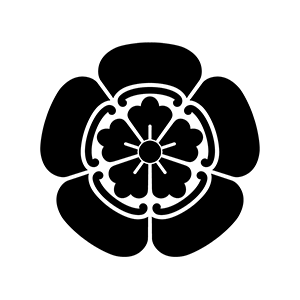Shimabara Domain (2/2)The stage of the largest civil war of the Edo period, the Shimabara Rebellion

Arima family crest: “Five melons and Chinese flowers”
- Article category
- History of the domain
- domain name
- Shimabara Domain (1616-1871)
- Affiliation
- Nagasaki Prefecture
- Related castles

Shimabara Castle
- related castles
Tadafusa Takatsuki lived up to these expectations and successfully restored Shimabara through policies such as exempting Shimabara's farmers from tax for one year and encouraging ronin and others to immigrate.
The Takashi family was succeeded by their eldest son Takanaga Takaki, but he did not continue his father's reconstruction policy and imposed harsh taxes on farmers, so he was imprisoned in Kamisendai Castle.
Tadafusa Matsudaira, who was also a fudai daimyo, took over Shimabara instead of the Takari family.
It is also said that he was transferred to supervise the Nagasaki magistrate, as well as to monitor Nagasaki security forces and daimyo in the Saigoku region.
The Matsudaira family then took charge of Shimabara for five generations. The first lord of the domain, Tadafusa Matsudaira, established a policy to protect farmers, but due to natural disasters such as insect damage, the domain's government did not become stable.
For a time, Masakatsu Kurokawa, a vassal, became extremely tyrannical, so from the third generation lord, Tadayoshi Matsudaira, onward, he maintained a policy of thorough enforcement of discipline among his vassals.
During the time of the fifth lord, Matsudaira Tadaki, the domain was transferred to Shimotsuke Utsunomiya.
The person who replaced the Matsudaira family in Shimabara was Toda Tadayoshi. Although he retired early due to his poor health, he stipulated that the people of his territory who had committed a crime by expressing their ``Okyojo no Homo'' should not be punished harshly, but should change their hearts with their hearts and filial piety.
Tadahiro Toda, who succeeded him, was the lord of Shimabara, and at the same time held important positions in the shogunate, including Kyoto Shoshidai and Osaka Castlelord, and ended his life without much involvement in Shimabara politics.
After that, the Shimabara domain was again ruled by the Matsudaira family, but when Tadayasu Matsudaira, the 11th lord of the domain, took over the Shimabara territory from the Toda family, in 1792, Mt. Fugendake Bizan collapsed due to a violent earthquake. , a major disaster occurred in which most of Shimabara Castle was buried. (Tai Shimabara)
Matsudaira Tadayasu tried to rebuild his territory despite his illness, but due to stress, he died within a few months of the crisis.
The successive feudal lords who succeeded him did their best to rebuild the domain, but the scars of the Shimabara disaster were large and put a great deal of pressure on the domain's finances.
Furthermore, as foreign ships begin to appear in the seas within the territory, there is a need to strengthen the defense of the sea.
Perhaps due to such stress, the 12th lord, Tadakazu Matsudaira, was 49 years old, the 13th lord, Tadakazu Matsudaira, 43 years old, and all the lords from then on until the last lord, Tadakazu Matsudaira, were in their late teens to 20s. He has passed away.
The last feudal lord, Tadakazu Matsudaira, was the biological son of Tokugawa Nariaki and the half-brother of the last shogun, Tokugawa Yoshinobu. After he became the lord of the domain, he reformed the military system due to the need to strengthen coastal defense, but because the reconstruction of the domain was his top priority, he was unable to acquire Western-style military equipment like the Satsuma and Saga domains. did.
At the end of the Edo period, the first Choshu conquest took place on the side of the Shogunate. As a result, there was a backlash from the vassals, and some of the lower-ranking feudal retainers of the radical Sonjo school defected from the domain and joined the Tenchu-gumi Incident and the Tengu-to Rebellion, but this did not become enough to shake up the domain.
In the Boshin War that began in 1868, he sided with the new government and ushered in the Meiji Restoration.
In 1874, he became chief priest of Toshogu Shrine, and in 1884 he was made a viscount.
He passed away in 1917.
Shimabara clan summary
The Shimabara clan prospered through the red stamp ship trade in the early Edo period, but after the Shimabara Rebellion, the country became devastated and natural disasters occurred frequently, such as the frequent explosions at Mt. Unzen Fugendake.
Therefore, at the end of the Edo period, it was not as active as the Saga and Satsuma domains, and quietly welcomed the Meiji Restoration.
The last lord of the domain, Tadakazu Matsudaira, was Yoshinobu Tokugawa's half-brother, but he did not get too close to the shogunate.
Furthermore, the lineage of Nariaki Tokugawa, the lord of the Mito Tokugawa family, continues to this day.
Reread the article about the Shimabara clan
- related castles

- WriterAYAME(Writer)I am a writer who loves history, focusing on the Edo period. My hobbies are visiting historical sites, temples and shrines, and reading historical novels. If there is a place you are interested in, you can fly anywhere. I'm secretly happy that the number of sword exhibitions has increased recently thanks to the success of Touken Ranbu.



